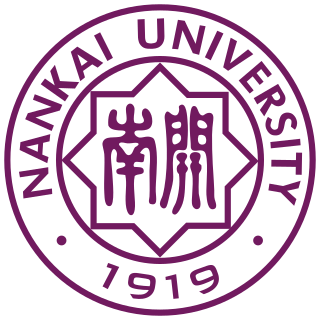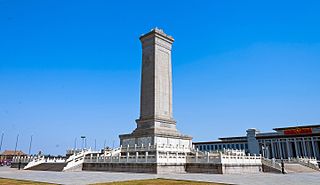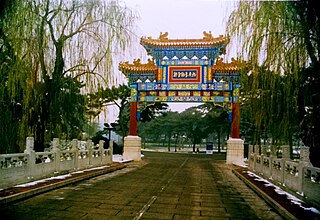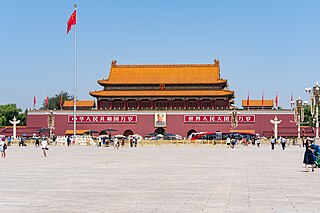
Zhou Enlai was a Chinese statesman, diplomat, and revolutionary who served as the first Premier of the People's Republic of China from September 1954 until his death in January 1976. Zhou served under Chairman Mao Zedong and aided the Communist Party in rising to power, later helping consolidate its control, form its foreign policy, and develop the Chinese economy.

The 1976 Tiananmen incident or the April 5 Tiananmen incident was a mass gathering and protest that took place on April 4–5, 1976, at Tiananmen Square in Beijing, China. The incident occurred on the traditional day of mourning, the Qingming Festival, after the Nanjing incident, and was triggered by the death of Premier Zhou Enlai earlier that year. Some people strongly disapproved of the removal of the displays of mourning, and began gathering in the Square to protest against the central authorities, then largely under the auspices of the Gang of Four, who ordered the Square to be cleared.
The Four Modernizations were goals formally announced by China's first Premier Zhou Enlai to strengthen the fields of agriculture, industry, defense, science, and technology in China. The Four Modernizations were adopted as a means of rejuvenating China's economy in 1977, following the death of Mao Zedong, and later were among the defining features of Deng Xiaoping's tenure as the paramount leader of China. At the beginning of "Reform and Opening-up", Deng further proposed the idea of "xiaokang" or "Moderately prosperous society" in 1979.

Nankai University is a public university in Tianjin, China. It is affiliated with the Ministry of Education of China. The university is part of Project 211, Project 985, and the Double First-Class Construction.

Shaoxing is a prefecture-level city on the southern shore of Hangzhou Bay in northeastern Zhejiang province, China. Located on the south bank of the Qiantang River estuary, it borders Ningbo to the east, Taizhou to the southeast, Jinhua to the southwest, and Hangzhou to the west. As of the 2020 census, its population was 5,270,977 inhabitants among which, 2,958,643 lived in the built-up area of Hangzhou–Shaoxing, with a total of 13,035,326 inhabitants.

Zhongnanhai is a compound that houses the offices of and serves as a residence for the leadership of the Chinese Communist Party (CCP) and the State Council. It was a former imperial garden, and is located adjacent to the Forbidden Palace in Beijing. The term Zhongnanhai is often used as a metonym for China's central government and its leadership at large.

Huai'an, formerly Huaiyin, is a prefecture-level city in central Jiangsu Province in Eastern China. As of 2020, the built-up area (metro) of its 3 central urban districts had 2,544,767 inhabitants and the prefecture-level city as a whole had 4,556,230 inhabitants, down from 4.8 million in 2010.

The Monument to the People's Heroes is a ten-story obelisk that was erected as a national monument of China to the martyrs of revolutionary struggle during the 19th and 20th centuries. It is located in the southern part of Tiananmen Square in Beijing, in front of the Mausoleum of Mao Zedong. The obelisk monument was built in accordance with a resolution of the First Plenary Session of the Chinese People's Political Consultative Conference (CPPCC) adopted on November 30, 1949, with construction lasting from August 1952 to May 1958. The architect of the monument was Liang Sicheng, with some elements designed by his wife, Lin Huiyin. The civil engineer, Chen Zhide (陈志德) was also instrumental in realizing the final product.

Mount Lu or Lushan is a mountain situated in Jiujiang, China. It was also known as Kuanglu in ancient times. The mountain and its immediate area are officially designated as the Lushan National Park, and it is one of the most renowned mountains in the country. Mount Lu is located primarily in Lushan City within Jiujiang, although its northern portions are found in Jiujiang's Lianxi District. The oval-shaped mountains are about 25 kilometers (16 mi) long and 10 kilometers (6.2 mi) wide, and neighbors Jiujiang and the Yangtze River to the north, Nanchang to the south, and Poyang Lake to the east. Its highest point is Dahanyang Peak (大汉阳峰), reaching 1,474 meters (4,836 ft) above sea level. Dahayang Peak is also one of the hundreds of steep peaks that tower above the so-called sea of clouds that can encompass the mountain for almost 200 days each year.

Chongqing Nankai Secondary School (重庆南开中学) is a public secondary school in Shapingba, Chongqing, China.

Tianjin Nankai High School is a college-preparatory high school in Tianjin, China. This is the original Nankai High School, and it is often referred to as Nankai High School in Tianjin to differentiate it from Chongqing Nankai Middle School, its sister school in Chongqing. Nankai is notable as one of the first modern secondary schools in China, and boasts several of the most notable men in modern Chinese history as its alumni. The main campus is located at 22 Nankai 4th Rd in Nankai District. The other two campuses are in Sino-Singapore Tianjin Eco-city and Haihe Jiaoyu Yuanqu, Tianjin.

The Diaoyutai State Guesthouse (DSG) (simplified Chinese: 钓鱼台国宾馆; traditional Chinese: 釣魚臺國賓館; pinyin: Diàoyútái Guóbīnguǎn) is an ancient royal garden and modern state guesthouse-complex located on the east side of Yuyuantan Park in Haidian District, Beijing, China. Emperor Zhangzong of Jin once built a fishing platform here, thus the name "Diaoyutai", which has a history of more than 800 years. During the Qing Dynasty, the Qianlong Emperor ordered to dredge the Yuyuantan and build a palace here, which was then turned into a royal garden. The modern State Guesthouse Park was built by the government of the People's Republic of China in 1958-1959 on the basis of the ancient Diaoyutai Scenic Spot, as a place for visiting dignitaries to stay and for meetings and conferences. Diaoyutai State Guesthouse is located outside Fuchengmen in western Beijing, east of Yuyuantan, southwest of the intersection of Fucheng Road and Sanlihe Road.

The Kashmir Princess, or Air India Flight 300, was a chartered Lockheed L-749A Constellation Air India flight. On 11 April 1955, it was damaged in midair by a bomb explosion and crashed into the South China Sea while en route from Bombay, India, and Hong Kong to Jakarta, Indonesia. Sixteen of those on board were killed, while three survived. The explosion was an assassination attempt targeting Chinese Premier Zhou Enlai, who missed the flight either due to a medical emergency or, as one historian concluded, because he had prior knowledge. The Chinese government insisted that Hong Kong authorities investigate; they concluded that the Kuomintang (KMT) were responsible for the bombing.

Hoh Fuk Tong Centre is located at 28 Castle Peak Road - San Hui, San Hui, Tuen Mun, New Territories, Hong Kong near Light Rail Hoh Fuk Tong stop. Morrison Building is a declared monument of Hong Kong.

Chang Po-ling was a Chinese educator who, with Yan Xiu, founded Nankai University and the Nankai system of schools.

Tiananmen Square or Tian'anmen Square is a city square in the city center of Beijing, China, named after the eponymous Tiananmen located to its north, which separates it from the Forbidden City. The square contains the Monument to the People's Heroes, the Great Hall of the People, the National Museum of China, and the Mausoleum of Mao Zedong. Mao Zedong proclaimed the founding of the People's Republic of China in the square on October 1, 1949; the anniversary of this event is still observed there. The size of Tiananmen Square is 765 x 282 meters. It has great cultural significance as it was the site of several important events in Chinese history.
The North Jiangsu Main Irrigation Canal is located in the lower reaches of the Huai River, one of the major rivers in the north of Jiangsu Province, China. It originates at Gaoliangjian on Hongze Lake and runs through Hongze, Qingpu, Huai'an, Funing, Sheyang and Binghai county(or district) and joins the artificial estuary of Biandan Harbour. The canal is 168 km in length and can irrigate 1,720,000 hectares of farmland. The construction program was organized and directed by the headquarters of the Jiangsu Huai River management program between October 1951 and May 1952.

Yan Xiu, also known as Yan Fansun, was a Chinese educator who, with Zhang Boling, founded Nankai University and the Nankai system of schools.

Nankai Institute of Economics is an economic research institute affiliated to the Nankai University School of Economics. It is located within the university's Balitai campus at Nankai District, Tianjin. The institute was founded in 1927 by He Lian and Zhang Boling, was originally named Nankai Committee of Sociology and Economics. It changed its name into Nankai Institute of Economics in 1931, and then established the tenet of the institute, which is to "know China and serve China". The systematic social research that the institute has conducted was ahead of its time in China. The Nankai Price Index, compiled in 1927, was the very first price index in China and the most important reference to the study of Chinese economy during that time, indicating that it was rather influential and of high academic value. The institute was then regarded as the authority of Chinese economic studies during the period of Republic of China (1912–1949).

Shuishanggongyuan Subdistrict is a subdistrict situated on the south of Nankai District, Tianjin, China. It borders Xuefu Subdistrict to the north, Machang and Tianta Subdistricts to the east, Tiyuzhongxin Subdistrict to the south, and Wangdingdi Subdistrict to the west. Its population was 64,853 as of 2010.

















